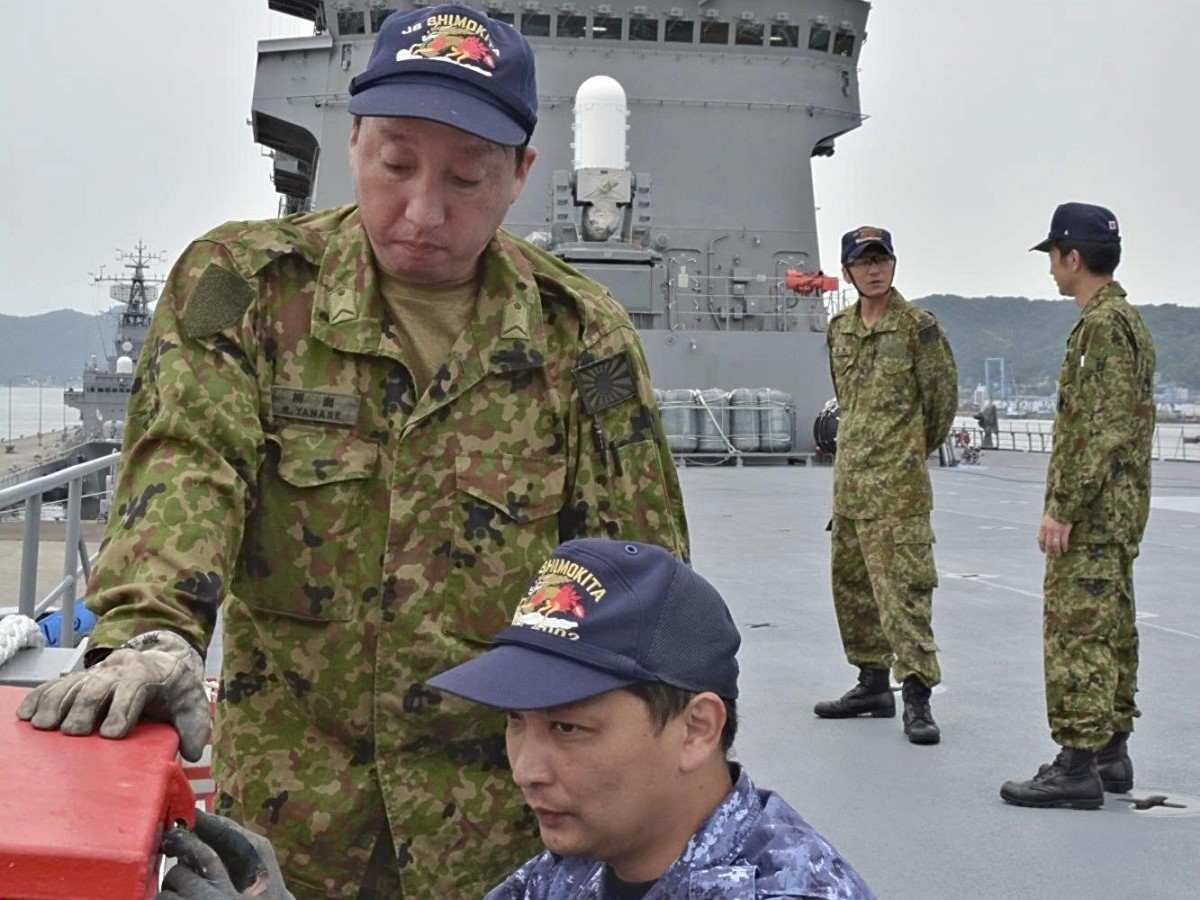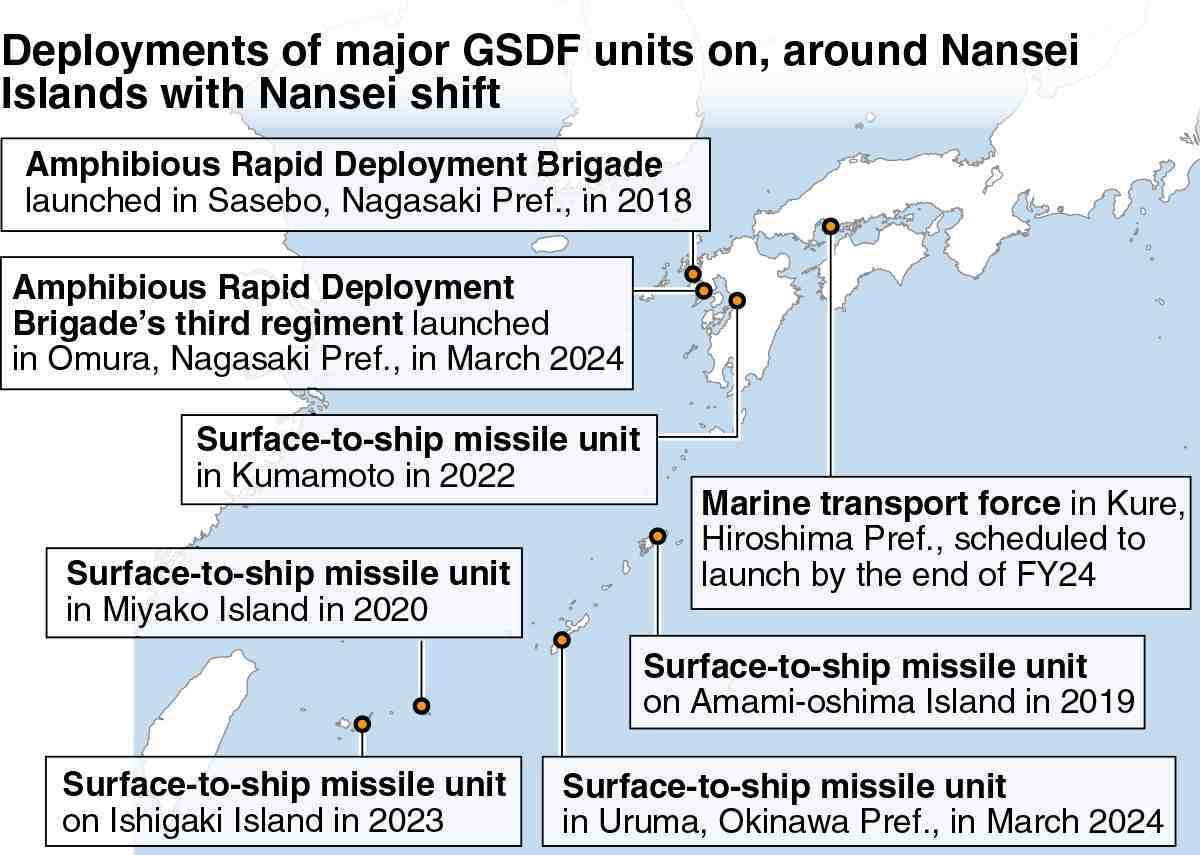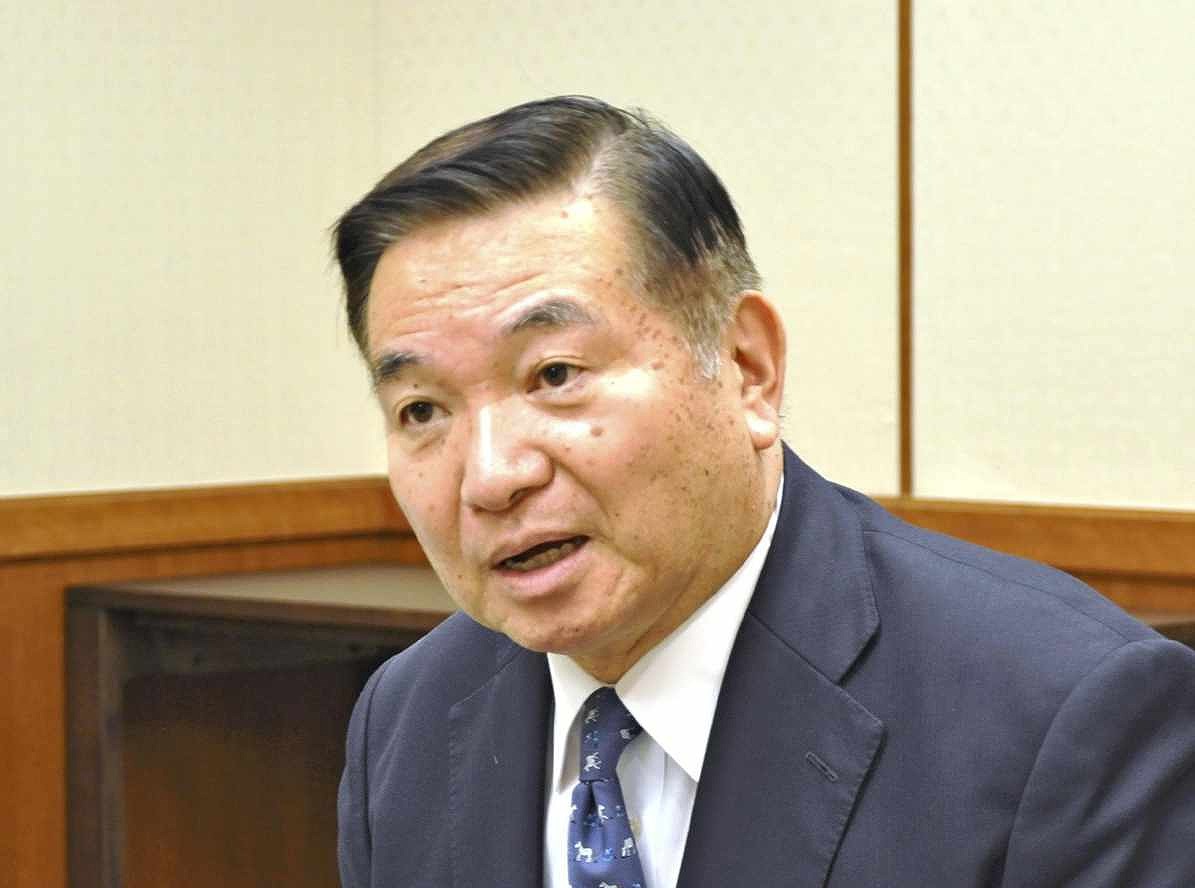SDF 70 yrs on — Expanding Roles / Japan Trains Its Ground Troops to Be Sailors, in Bid to Strengthen SDF’s Transport Network

A Maritime Self-Defense Force member, front, checks devices with Ground Self-Defense Force personnel on the deck of the MSDF transport ship Shimokita, in Kure, Hiroshima Prefecture, on June 25.
13:26 JST, July 10, 2024
The Self-Defense Forces were established on July 1, 1954. In the past 70 years, the security situation around Japan has changed drastically, with the Soviet Union breaking apart and China now rapidly building up its military. This is the first installment in a series of articles reporting on the current state of the SDF, whose role is growing broader.
***
On June 25 aboard the Shimokita transport ship anchoring at the Maritime Self-Defense Force’s Kure Base in Kure, Hiroshima Prefecture, a Ground Self-Defense Force officer was seen among MSDF personnel. The officer wore a green camouflage uniform amid the blue uniforms of the MSDF.
From the bridge, the officer steered the ship, which displaces 8,900 tons of water, and on the deck he checked cargo. This officer was Maj. Shintaro Iwata, 44, who is one of the GSDF staff crewing the Shimokita as navigation commanders.
Iwata formerly belonged to the GSDF’s transport unit, and for some time he worked as a truck driver transporting cargo.
In the past, GSDF staff on transport ships were just being transported to mission sites as part of GSDF units. But that has changed.
The SDF has taken measures to train sailors inside the GSDF. The aim is to foster ship crews for the marine transport force, which is scheduled to be launched by the end of fiscal 2024. As the new force will have about 100 members, mainly from the GSDF, the GSDF has been dispatching its staff to the MSDF since fiscal 2019.
“In an emergency, an important task will be deploying personnel units and supplies to islands,” Iwata said. “I would like to see the GSDF able to operate transport ships.”
The SDF grew out of the National Police Reserve, which was launched in August 1950, after the start of the Korean War in June 1950.
The potential enemy in those years was the Soviet Union, and so the GSDF prepared for threats from the north by deploying a large number of tanks in Hokkaido.
But with the Soviet Union having fallen apart and China now on the rise, the SDF has rapidly shifted focus to the Nansei Islands since the early 2010s.
And with the specter of a military emergency in Taiwan, the front line of presumed threats has shifted from Hokkaido to the small islands of the Nansei island chain.
While the SDF has reduced its arsenal of heavy weapons such as tanks and field artillery, it is strengthening mobile power for the remote islands.
Setting up the marine transport force is also part of the Nansei shift. The MSDF has no room to handle more transport ships as it is occupied by such tasks as surveillance in the East China Sea and responding to North Korea’s ballistic missile launches.
By fiscal 2027, the marine transport force is scheduled to operate two midsize ships, four small ships and four mobile boats.
‘Japan’s Marine Corps’

At a beach in Minami-Shimabara, Nagasaki Prefecture, on June 21, 119 members of the GSDF’s Amphibious Rapid Deployment Brigade were being instructed by officers about a landing operation for a remote island.
They formed eight-member groups, prepared rubber boats and entered the sea. Then they paddled while shouting, “One, two, one, two,” and reached a point one kilometer out, before turning and paddling back.
The brigade was established in 2018 to take charge of the defense and recapture of remote islands. It has been called “Japan’s Marine Corps.”
In March this year, the brigade’s third amphibious rapid deployment regiment was newly launched with about 600 members.
Together with the first and second regiments, the brigade now has more than 3,000 members. Morale is high among the elite corps, which is set to play a key role in the Nansei shift.
“We are determined to be on the front line of the national defense if an emergency occurs in the Nansei Islands,” said the brigade’s Capt. Kyohei Iwaida, 31.
Counterattack capabilities
Washington and Canberra conducted their Talisman Sabre joint drill in July and August last year in Australia. Eleven other countries, including Japan, South Korea and Britain, also participated in the drill.
During the joint drill, the GSDF fired one Type 12 surface-to-ship guided missile with a range of about 100 kilometers and successfully hit a mock ship.
It was the first time the GSDF fired the missile other than during drills in the United States.
The Japanese government decided to acquire counterattack capabilities to hit enemy bases in its National Security Strategy, which was compiled in December 2022.
This was a drastic change in Japan’s defense policy, and the government aims to accelerate a deterrence buildup as it prepares for emergencies.
At the core of Japan’s domestically made arsenal for counterattack capabilities is an improved version of the Type 12 surface-to-ship guided missile, which will have a range of about 1,000 kilometers.
The GSDF plans to speed up development of the new missiles for deployment in fiscal 2025. The GSDF is also deploying missile units in Okinawa Prefecture, such as to Miyako and Ishigaki islands, as part of the Nansei shift.
“It’s important to make [potential enemies] think that attacking Japan would be a major risk for their side,” a senior SDF official said.
"Politics" POPULAR ARTICLE
-

Japanese Language Requirement Eyed for Permanent Residency Status; LDP Plans Revisions of Laws on Foreigners
-
-250x167.jpg)
Japan Eyes Plan to Accept Up To 1.23 Mil. Foreign Workers by End of Fiscal 2028
-

AI-Driven ‘Zero Clicks’ Phenomenon Threatens Democracy; News Outlets Must Be Able to Recover Costs, Stay Independent
-

Japanese Public, Private Sectors to Partner on ¥3 Tril. Project to Develop Domestic AI, SoftBank to Be Key Firm Involved
-

Japan’s Defense Ministry to Extend Reemployment Support for SDF Personnel to Age 65; Move Comes Amid Ongoing Labor Shortage
JN ACCESS RANKING
-

As Chinese Tourists Shun Japan, Hotels and Stores Suffer
-

Core Inflation in Tokyo Slows in December but Stays above BOJ Target
-

BOJ Gov. Ueda: Highly Likely Mechanism for Rising Wages, Prices Will Be Maintained
-

Osaka-Kansai Expo’s Economic Impact Estimated at ¥3.6 Trillion, Takes Actual Visitor Numbers into Account
-

Japan Govt Adopts Measures to Curb Mega Solar Power Plant Projects Amid Environmental Concerns


























